Gayla L. Poling, Ph.D., Chief Research Audiologist
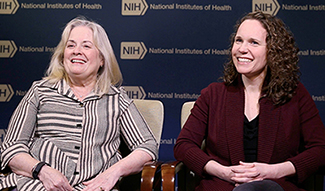
This video explores how NIDCD audiologists in the NIH Clinical Center's Audiology Unit help to treat young patients with a rare disease.
Research Statement
The Audiology Unit functions as both a research and clinical laboratory. Within these broad areas, we develop and conduct audiology-specific research studies; collaborate with intramural investigators in the development and implementation of protocols that include assessment of the auditory and vestibular systems; provide audiology services to support NIH Clinical Center patient needs; and provide clinical and research training and mentoring.
Currently, our research can be divided into four areas: 1) natural history of disorders affecting the auditory and vestibular systems; 2) clinical monitoring of potentially ototoxic therapeutic and diagnostic interventions; 3) auditory processing skills; and 4) investigation of normal variation in auditory and vestibular function.
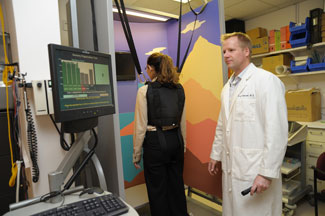
Christopher Zalewski, Ph.D., assesses balance function using dynamic computerized platform posturography.
Our natural history studies are directed toward identifying and defining distinctive auditory and vestibular phenotypes, understanding their pathogenesis, and correlating these phenotypes with underlying molecular genotypes. Many of our studies are multidisciplinary and part of NICHD, NEI, NCI, NIAMS, NINDS, and NHGRI clinical research protocols on a variety of chromosomal and syndromic disorders affecting hearing and balance. We use a comprehensive battery of auditory and vestibular measures that includes otoacoustic emissions, wideband acoustic reflectance, assessment of auditory processing, auditory and vestibular evoked potentials, videonystagmography, rotary vestibular testing, and computerized dynamic platform posturography. Examples of ongoing research include examining auditory and/or vestibular manifestations of neurofibromatosis type 2 (NF2), Usher syndrome, enlarged vestibular aqueducts (EVA), Niemann-Pick type C (NPC), xeroderma pigmentosum (XP) and Moebius syndrome.
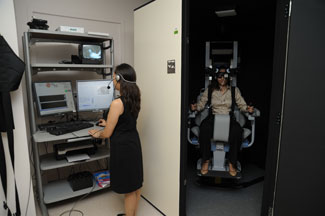
Vestibular function is assessed using rotary vestibular testing.
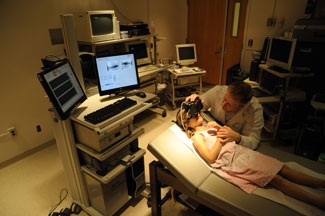
Videonystagmography is used to assess vestibular function.
Our clinical monitoring studies focus on hearing loss and other aspects of auditory function associated with ototoxins and clinical noise (e.g., MRI, TMS). They are conducted with the aim of early identification of hearing loss or other subtle damage to the ear as well as long term monitoring of patients treated with potentially ototoxic drugs such as aminoglycoside antibiotics, cisplatinum, experimental therapies, and as the result of radiation therapy to the brain. One investigation in which the NIDCD Audiology Unit has been involved combines a natural history study and clinical monitoring of hearing function during an experimental treatment of persons with Niemann-Pick type C1, a rare, progressive, and fatal disease.
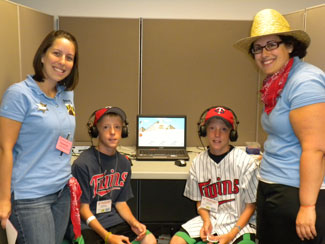
Audiology students prepare to test auditory processing skills of twins.
We conduct studies of auditory processing (AP) that focus on heritability of these skills in the general population and manifestation of these abilities in certain patient groups. In conjunction with the NIDCD’s Laboratory of Molecular Genetics we have shown that dichotic listening, or the ability to listen to and understand different speech signals presented to each ear at the same time, is inherited (Morell, et al. 2007). We have recently expanded our findings to show that there is heritability for AP of non-speech signals as well (Brewer et al., in press). This will enable us to understand better the underpinnings of AP. To date, much of this work was conducted at the Annual Twins Days Festival in Twinsburg, Ohio, where our team of researchers evaluated the AP skills of volunteer twin pairs. We are also examining AP skills in groups of patients with syndromes that may affect AP such as OCA, NF1 and WAGR syndrome.
We also investigate normative aspects of auditory and vestibular function in healthy volunteers. Our goals are to better understand normal function, determine ranges of normal variability, and identify the best and novel methods for evaluating the auditory and vestibular systems. We are currently examining the feasibility of methods to evaluate otolith organs of the balance system using rotary vestibular testing and measures of eye muscles associated with the vestibular system (ocular vestibular evoked myogenic potentials or oVEMP). In a separate study, we are evaluating stability of auditory nerve responses to sound over repeated measures with the goal of using this as a monitoring tool for subtle changes in auditory function that are not detected by a standard audiogram.
Student Mentorship Programs
The Audiology Unit offers clinical and research mentorship opportunities. A placement at the NIH is best suited for a person who is interested in the medical or genetic aspects of audiology, or both, as well as those who may have an interest in eventually pursuing a Ph.D. or a career in research. Please see How to Apply for Clinical and Research Mentorship Opportunities in the NIDCD Audiology Unit for application instructions.
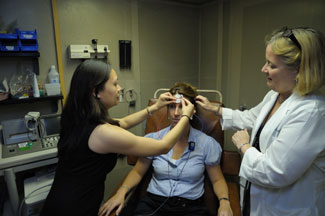
Dr. Brewer provides instruction to a student as a patient is prepared for auditory evoked potential testing.
Clinical mentorship opportunities for Doctor of Audiology (Au.D) students and Ph.D. students
The Audiology Unit is located in the NIH Clinical Center, the world’s largest biomedical research hospital. Learning opportunities include working with trans-disciplinary research and medical staff and attending NIDCD seminars and other NIH-sponsored lectures from world-renowned scientists and clinicians.
The NIH clinical research setting provides extensive audiological and vestibular diagnostic testing for adult and pediatric populations with rare diseases and syndromes; patients on potentially ototoxic and/or investigational treatments; and healthy volunteers. Students will help perform hearing evaluations, comprehensive middle ear assessments, sedated and unsedated evoked potentials testing, and auditory processing testing. In addition, the NIH Audiology Unit has an extensive vestibular lab where students receive training in the assessment and interpretation of posturography, videonystagmography (VNG), rotational testing, vestibular-evoked myogenic potentials (VEMP), and the video head impulse test (vHIT). They will present cases, participate in Journal Club, and strengthen history taking, counseling, and report writing skills.
The Audiology Unit does not fit amplification, so this position will not be a good fit for students who wants to work with hearing aids or cochlear implants as part of their externship experience.
Au.D. student externship
The Audiology Unit offers a 12-month, full-time Au.D. externship position that provides clinical experience anchored in NIH research. This position is ideally suited for the student with a strong interest in research in addition to clinical audiology. The audiology extern typically participates in a research project and takes part in activities to develop the administrative skills necessary for a successful audiology practice.
Au.D. student internships
The Audiology Unit offers Au.D. student placements for fall, spring, and summer, in conjunction with the student’s academic program. Because our program includes many advanced tests and patients with complex conditions, this rotation is recommended for the advanced Au.D. student who has already acquired basic clinical skills. This will allow the student to benefit from the unique aspects of our program.
Research Opportunities
Semester, summer, and project-based research opportunities are available to high school, undergraduate, and graduate students.
Summer research program: This opportunity is available to high school, undergraduate, and graduate students and is subject to availability from year-to-year depending on research needs. Projects include retrospective review and data analysis, and preparation for data acquisition for upcoming projects. Those interested in participating in the NIH summer student research program must apply though www.training.nih.gov/programs/sip. We give preference to those pursuing a career in audiology or hearing science. Summer students participate in lab meetings and journal club. Those completing a project with data analysis are expected to present at least one status report in our lab meetings and to prepare a poster for presentation at the NIH Summer Research Festival.
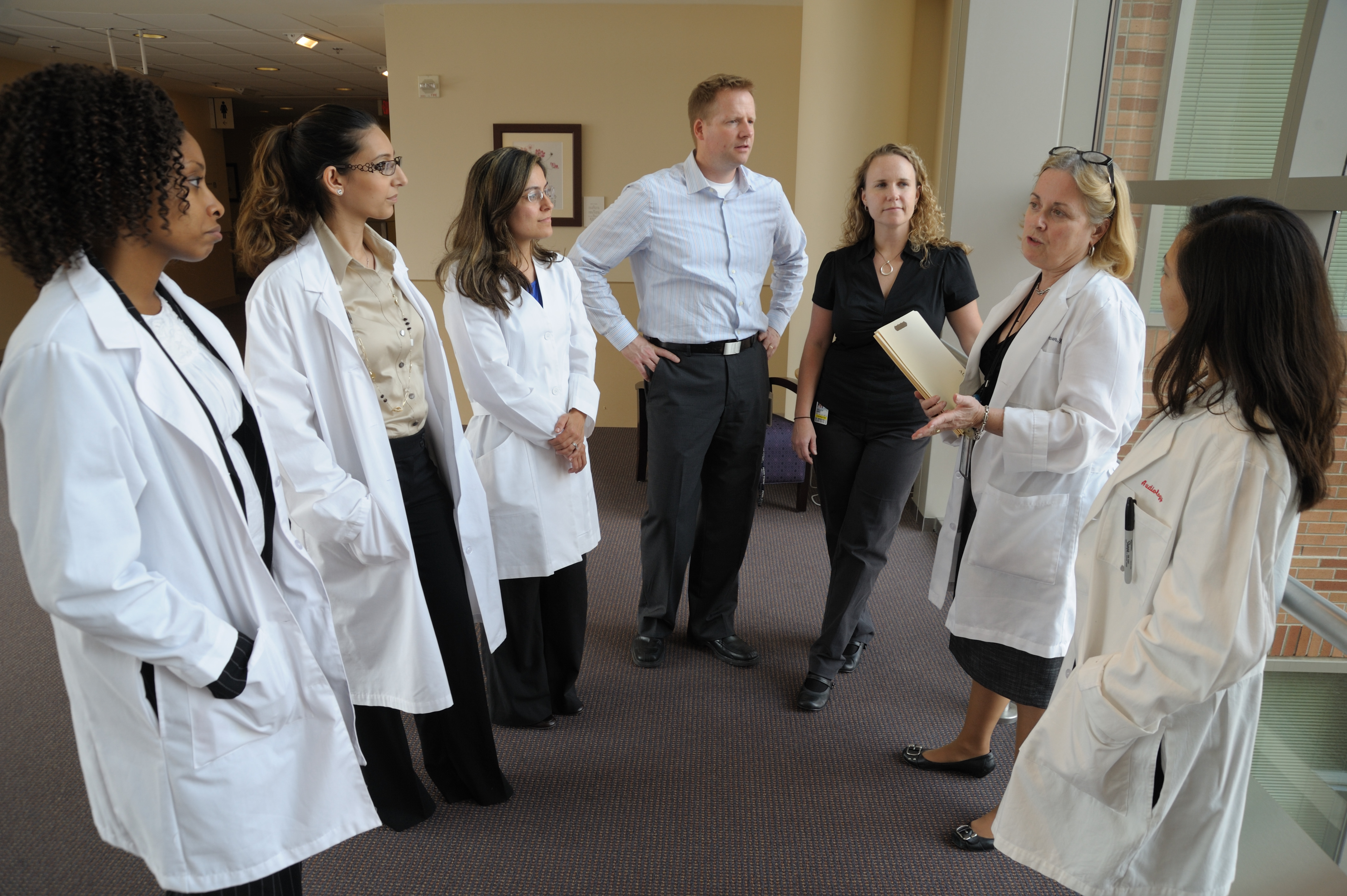
Case discussion with audiology students.
Semester- and project-based research: This opportunity is available to doctoral students in audiology/hearing science who are seeking to complete a research project as part of their academic requirements for the doctoral degree. We primarily offer opportunities for retrospective review and data analysis, and mentor the student through literature review, design of experimental questions, database management, statistical analysis, and research product development. The research product may be a capstone project, thesis, dissertation, research poster, and/or a manuscript submitted for publication. Independent work is expected. Approval by your academic advisor is required before we will agree to a research rotation. You will be required to lead at least one journal club, and make at least one presentation during lab meeting.
Selected Student Projects
- Megan Brenda, B.A. postbaccalaureate IRTA, undergraduate degree in psychology and speech and hearing sciences, University of Mexico. Brendal M, King K, Zalewski C, Finucane B, Introne W, Brewer C, Smith A. Auditory phenotype of Smith-Magenis syndrome. Poster presented at American Society of Human Genetics, Baltimore, October 2015.
- Hope Schmid, undergraduate communication sciences and disorders major, The Pennsylvania State University, University Park, PA. Schmid H, King K, Zalewski C, Giri N, Alter B, Kim HJ, Brewer C. The power of reflectance: identifying middle ear abnormalities in Fanconi Anemia. Poster presented at the NIH Summer Student Poster Series, August 2015.
- Spencer Lindsey, M.D., otolaryngology resident, Georgetown University, Washington DC. Lindsey S, Brewer C, Stakhovskaya O, Kim HJ, Zalewski C, King K, Marshall J, Gunay-Aygun M. Auditory and otologic phenotypic manifestations of Alstrom syndrome. Poster presented at the Combined Otolaryngology Spring Meeting, Boston, April 2015.
- Olga Stakhovskaya, M.D., Ph.D., doctoral student in audiology (Au.D.), University of Maryland, College Park, MD. Stakhovskaya O, King KA, Zalewski CK, Warren K, Adams D, Brewer C. Long-term stability and accuracy of otoacoustic emissions in pediatric ototoxicity monitoring. Poster presented American Auditory Society Scientific and Technical Meeting, Scottsdale, AZ, March 2015 *Travel award winner.
- D. Rudyard Nast, B.S., doctoral student in audiology (Au.D.), University of Florida, Gainsville, FL. Nast DR, Zalewski C, King K, Manoli I, Sloan J, Venditti C, Brewer C. Auditory Phenotype of patients with isolated methylmelonic acidemia. Poster presented American Auditory Society Scientific and Technical Meeting, Scottsdale, AZ, March 2014. *Travel award winner.
- Talah Wafa, Au.D., doctoral student in audiology and hearing science, Gallaudet University, Washington DC. Wafa T, Shultz J, Zalewski C, King K, Turiff A, Griffith A, Friedman T, Zein W, Brewer C. Comprehensive vestibular assessment in Usher syndrome: Genotype/phenotype correlations. Poster presented at NIH Research Festival, Bethesda, October 2013.

